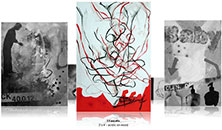So I ask these two questions as illustrative examples:
- Would Vincent Van Gogh be as famous as he is without a cloud of psychological disorders surrounding his life?
- Would Pablo Picasso's 'blue period' painting - The Old Guitarist - be as interesting as it in fact is if it were not painted when Picasso was "blue" with depression?
When one looks at the world through the glasses of the mentally ill... things look different! So to say that when someone like Van Gogh self chastises himself by sleeping on the hard wood floor instead of the empty bed next to him (because of thoughts of other human beings in the world not having a bed) potentially hinges the state of the mind to a higher, more romantic level that can see views, perspectives, textures and colors that normal everyday states of mind can not.
I've often found it interesting how many of the great artists and fine artists from the past have been associated with some form of mental illness. Two examples for this post are: Vincent Willem van Gogh - any number of his pieces; and Pablo Picasso - specifically his Blue Period.
From http://en.wikipedia.org/wiki/Van_Gogh
 "Van Gogh cut off the lobe of his left ear during some sort of seizure on 24 December 1888. Mental problems afflicted him, particularly in the last few years of his life...There has been much debate over the years as to the source of Van Gogh's mental illness and its effect on his work. Over 150 psychiatrists have attempted to label his illness, and some 30 different diagnoses have been suggested. Diagnoses which have been put forward include schizophrenia, bipolar disorder, syphilis, poisoning from swallowed paints, temporal lobe epilepsy and acute intermittent porphyria. Any of these could have been the culprit and been aggravated by malnutrition, overwork, insomnia, and a fondness for alcohol, and absinthe in particular."
"Van Gogh cut off the lobe of his left ear during some sort of seizure on 24 December 1888. Mental problems afflicted him, particularly in the last few years of his life...There has been much debate over the years as to the source of Van Gogh's mental illness and its effect on his work. Over 150 psychiatrists have attempted to label his illness, and some 30 different diagnoses have been suggested. Diagnoses which have been put forward include schizophrenia, bipolar disorder, syphilis, poisoning from swallowed paints, temporal lobe epilepsy and acute intermittent porphyria. Any of these could have been the culprit and been aggravated by malnutrition, overwork, insomnia, and a fondness for alcohol, and absinthe in particular."From http://en.wikipedia.org/wiki/Picasso's_Blue_Period
 "The Old Guitarist is a painting by Pablo Picasso, painted in 1903, just after the suicide death of Picasso's close friend, Casagemas."
"The Old Guitarist is a painting by Pablo Picasso, painted in 1903, just after the suicide death of Picasso's close friend, Casagemas."Let's think about these artists/artworks for a moment.
Now think about what these artworks would have looked like if these respective artists were on an SSRI (Selective serotonin reuptake inhibitors) or other class of antidepressants. Would the artists/artworks be as interesting or successful if they had been dulled by a brain balancing chemical like Zoloft. What would the art look like without the contribution of the disorderly, unbalanced mental state at the time of creation? Without these mental attributions, would these pieces even be worth blogging about?

1 comments:
Aothere example is Edvard Munch's 'Scream'
Post a Comment